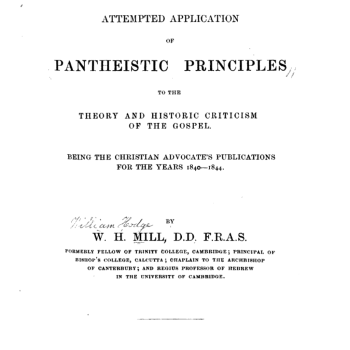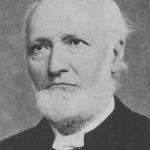Lucas Banzoli is a very active Brazilian anti-Catholic polemicist, who holds to basically a Seventh-Day Adventist theology, whereby there is no such thing as a soul that consciously exists outside of a body, and no hell (soul sleep and annihilationism). This leads him to a Christology which is deficient and heterodox in terms of Christ’s human nature after His death. He has a Master’s degree in theology, a degree and postgraduate work in history, a license in letters, and is a history teacher, author of 25 books, as well as blogmaster (but now inactive) for six blogs. He’s active on YouTube.
***
The words of Lucas Banzoli will be in blue. I used Google Translate to transfer his Portugese text into English.
*****
This is a reply to Lucas’ article, “Os irmãos de Jesus eram primos?” [Were Jesus’ brothers cousins?] (9-21-12).
The Catholic Church teaches that Jesus’ brothers weren’t really brothers – they were cousins! It asserts that Aramaic makes no distinction between cousin and brother, and therefore the Lord’s brothers were mere cousins. It really is very touching that Aramaic does not have this definition, but it is a pity that it has absolutely nothing to do with the original New Testament, which was written in Greek rather than Aramaic.
It certainly does have to do with the New Testament, even though it is in Greek, because the literal translation of whatever the Aramaic word for brother is, would be the corresponding word for brother in Greek (adelphos). It’s translating the term that applies to siblings as well as all sorts of relatives, kinsmen, countrymen. Adelphos has that very wide usage as well (as Lucas himself notes below in citing a linguistic reference source).
This is why it is standard practice to translate adelphos as brother in English, because that is the corresponding term. It simply has a very wide latitude of meaning. In fact, an example of this happened to me a few days ago when Brazilian Protestant apologist Francisco Tourinho (we’ve now had one theological exchange) called me “brother” in a private message. We just “met” each other online and are from different countries, ethnic groups, religious views, and generations, but that’s what he called me, because all Christians are “brothers.” Ancient Jews expressed relationships in this same fashion.
And while Aramaic leaves something to be desired in this regard, Greek is as clear and specific as Portuguese. In Greek, there is a specific word for cousin, brother and relative. Let’s look at the meanings of each word according to Strong’s Concordance lexicon:
431 ανεψιος anepsios
of 1 (as a union particle) and an archaic particle nepos (a relative); no
1) cousin.
80 αδελφος adelphos
from 1 (as a connective particle) and delphus (the womb); TDNT 1:144.22; no
1) a brother, whether born of the same parents, or only of the same father or mother.
2) having the same national ancestor, belonging to the same people or countryman.
3) any fellow or man.
4) a faithful companion, united to the other by the bond of affection.
5) an associate in employment or office.
6) brothers in Christ.
6a) his brethren by blood.
6b) all men.
6c) apostles.
6d) Christians, as those who are lifted up to the same heavenly place.
4773 συγγενης suggenes
from 4862 and 1085; TDNT – 7:736,1097; adj
1) of the same family, similar to, blood relative.
2) in a broader sense, of the same nation, fellow countryman.
English has the word “cousin” too, but it’s usually not used to translate adelphos because of what has been explained above.
Therefore, we see that:
Anepsios – Cousin
Adelphos – Brother
Sugges – Relative
The only word that has a broader meaning is adelphos, which figuratively or spiritually means “brothers in Christ”, or “companion”, and not blood brother. It can also mean a blood brother only on the paternal or maternal side. However, as both cases are rejected by the Roman Church (the Orthodox adopts the second position, while the Roman maintains that they are cousins), I will not base myself on these secondary meanings, but only on the primary one, that is, of brother by blood, which they were not Joseph’s children by a previous marriage. The case we see here, therefore, is very curious. We have three Greek words for kinship. One is just a “close relative”, another is specifically “cousin”, and the other is a real “brother”. One would expect, for obvious reasons, that whenever Jesus’ “cousins” were mentioned, the word anepsios would be present, but this is absolutely not the case in any quotation of Jesus’ brothers.
It is not “obvious” and we should not expect adelphos to be translated as “cousin” in these instances, as explained. But this doesn’t prove they aren’t cousins or possibly step brothers (the eastern Catholic and eastern Orthodox favored position).
In absolutely every quote, we see adelphos (brothers, not cousins) being used to designate Christ’s brothers.
That is correct, and it poses no problem whatsoever for the Catholic position of the perpetual virginity of Mary (Jesus being her only child). Providing examples of the usage proves nothing one way or another as to this debate. So I won’t reproduce all that; readers can read them in his article: linked above.
We see, therefore, that in absolutely every time when someone referred to the brothers of the Lord (or to a specific brother), he used adelphos, and not anepsios. Therefore, to say that the brothers of the Lord were anepsios (cousins) and not adelphos (brothers) because of Aramaic is laughable and is at least a joke.
It’s not at all, once we examine all of the relevant biblical data, as I will do.
Imagine you knowing that the Lord’s brothers were merely cousins, and having the word for “cousin” (anepsios) ready, at hand, which can be perfectly used by you when you want to your good will, and even then you give up applying it. it every time someone refers to the brothers of Jesus, and instead always applies the word for brother (adelphos)! Is it possible to understand such a thing?
Of course it is. Lucas explained it himself when he cited all the meanings that adelphos can have.
How is it that in the dozens of biblical passages about the brothers of Jesus there is not even a single one that applies anepsio? To infer that they were cousins is to murder exegesis, mutilate Greek grammar, and pretend to be someone better than the apostles and evangelists, for they explicitly wrote adelphos and not anepsios! Furthermore, we have to remember that the apostle Paul, who twice referred to the brothers of Jesus as being adelphos (Gal.1:19; 1Co.9:5) and who never referred to them as anepsios, also had this option for anepsis ready and fully available, proof of this is that he employs it in Colossians 4:10:
“Aristarchus, my fellow prisoner, sends you his greetings, as does Mark, cousin of Barnabas. You have been instructed about Mark, and if he comes to visit you, welcome him” (Colossians 4:10)
“aspazetai umas aristarchos o sunaichmalôtos mou kai markos o anepsios barnaba peri or elabete entolas ean elthê pros umas dexasthe auton” (Colossians 4:10)
Paul’s letters were written in Greek, because they were written to Greek-speaking people. Therefore, he chose to use a Greek word for cousin (whereas Aramaic didn’t have such a word).
Paul says that Mark was a cousin (anepsios) of Barnabas, but he himself does not refer to Jesus’ brothers as cousins (anepsios), but as “brothers” (adelphos), and not in a figurative sense, for he distinguishes them from the rest of the disciples and apostles:
“Have we not a right to take with us a believing wife, as also the rest of the apostles, and the brethren of the Lord, and Cephas?” (1st Corinthians 9:5)
“mê ouk echomen exousian adelphên gunaika periagein ôs kai oi loipoi apostoloi kai oi adelphoi tou kuriou kai kêphas” (1 Corinthians 9:5)
Paul could also choose to use adelphos here, because it was understood in Greek to have a wide variety of meanings. Even today we (in English, at any rate) often use “brother” in the broader sense: “Band of brothers”, “Brother Jed will preach the sermon today”, “Brother” and “Sister” for monks and nuns (and non-literal “Father” for priests), “am I my brother’s keeper?”, Ringo Starr (an only child) calling the Beatles his “brothers” etc. Therefore, this use in and of itself doesn’t prove that he was referring to siblings of Jesus. It’s not funny or silly; it’s how language works.
It’s time to do some comparative exegesis now.
Jesus Himself uses “brethren” in the larger sense (Mt 23:1, 8; 12:49). In Matthew 23:8 (cf. 12:49-50), He calls, for example, the “crowds” and His “disciples” (23:1) “brethren.”
Matthew 13:55 (RSV) Is not this the carpenter’s son? Is not his mother called Mary? And are not his brothers James and Joseph and Simon and Judas?
Matthew 27:55-56, 61 There were also many women there [at the crucifixion], looking on from afar, who had followed Jesus from Galilee, ministering to him; [56] among whom were Mary Mag’dalene, and Mary the mother of James and Joseph, . . . [61] Mary Mag’dalene and the other Mary were there, sitting opposite the sepulchre.
Matthew 28:1 Now after the sabbath, toward the dawn of the first day of the week, Mary Mag’dalene and the other Mary went to see the sepulchre.
Mark 6:3 “Is not this the carpenter, the son of Mary and brother of James and Joses and Judas and Simon, . . .?” . . .
Mark 15:40, 47 There were also women looking on from afar, among whom were Mary Mag’dalene, and Mary the mother of James the younger and of Joses, and Salo’me, . . . [47] Mary Mag’dalene and Mary the mother of Joses saw where he was laid.
Mark 16:1 And when the sabbath was past, Mary Mag’dalene, and Mary the mother of James, and Salo’me, bought spices, so that they might go and anoint him.
John 19:25 . . . standing by the cross of Jesus were his mother, and his mother’s sister, Mary the wife of Clopas, and Mary Mag’dalene.
By comparing Matthew 27:56; Mark 15:40; and John 19:25, we find that James and Joseph – mentioned in Matthew 13:55 with Simon and Jude as Jesus’ “brethren” – are also called sons of Mary, wife of Clopas. This other Mary (Mt 27:61; 28:1) is called Mary’s adelphe in John 19:25 (two Marys in one family?! – thus even this usage apparently means “cousins” or more distant relative). Matthew 13:55 and Mark 6:3 mention Simon, Jude and “sisters” along with James and Joseph, calling all adelphoi. Since we know for sure from this information that James and Joseph are definitely not Jesus’ blood brothers, it is likely that all these other “brethren” are cousins, according to the linguistic conventions discussed above. Most Bible scholars equate Jude and Thaddeus. The latter is mentioned in two lists of the disciples that do not contain Jude: Matthew 10:3 and Mark 3:18; for more on this, see Wikipedia, “Jude the Apostle”.
In John 19:25, the apostle John calls Mary, wife of Clopas, the virgin Mary’s “sister” (adelphe). Is it Lucas’ belief that Mary, the mother of Jesus had a blood sister named Mary? Or is this a cousin or more distant relative? James and Joseph are called Jesus’ “brothers” in Mark 6:3 and Matthew 13:55. Yet Matthew 27:56 (cf. Mk 15:40) describes a different Mary as their mother (described as “the other Mary” in 27:61 and 28:1, and “Mary the wife of Clopas” in Jn 19:25). Now, assuming that Mary, the Mother of God didn’t have a sister (sibling) named Mary, this Mary, wife of Clopas and “sister” of the Blessed Virgin Mary is at least a cousin, if not further removed.
The Protestant New Bible Dictionary (1962) confirms all this (if indeed that is necessary with all that biblical data available). In its article, “Mary,” the fourth entry is about Mary, wife of Clopas:
Mary the mother of James; ‘the other Mary’; Mary of Clopas. It is very probable that these three names all refer to the same person. Mary the mother of James and Joses . . . (Mt. 27:55 f.) . . . Mark refers to her (15:40) as ‘Mary the mother of James the less and of Joses . . .
. . . Hegesippus [2nd cent.] tells us (see Eus., EH iii 11) that Clopas (AV Cleophas) was the brother of Joseph, the husband of the Virgin Mary. (p. 793)
If the latter is true, then Mary, wife of Clopas would have been the Blessed Virgin Mary’s sister-in-law; married to her husband’s brother. That would have made her Jesus’ aunt, and thus her sons would be His first cousins. Note the looseness of adelphos again: it is applied in John 19:25 to this “sister” of Mary, who is actually a sister-in-law and not blood-related at all (according to Hegesippus and Eusebius), or else a cousin (blood-related, but more distantly than a sibling).
We find more fascinating information in Eusebius, in the same passage cited above:
After the martyrdom of James and the conquest of Jerusalem which immediately followed, it is said that those of the apostles and disciples of the Lord that were still living came together from all directions with those that were related to the Lord according to the flesh [Williamson, 1965, translates this as “kinsmen of the Lord“] (for the majority of them also were still alive) to take counsel as to who was worthy to succeed James.
They all with one consent pronounced Symeon, the son of Clopas, of whom the Gospel also makes mention [Jn 19:25; perhaps Lk 24:18]; to be worthy of the episcopal throne of that parish. He was a cousin, as they say, of the Saviour. For Hegesippus records that Clopas was a brother of Joseph. (Book III, section 11, parts 1-2; translated by Arthur Cushman McGiffert. From Nicene and Post-Nicene Fathers, Second Series, Vol. 1. Edited by Philip Schaff and Henry Wace. [1890], pp. 123-124 in the version translated by G. A. Williamson, Baltimore: Penguin Books, 1965; my bolded and italicized emphases; cf. Book III, section 32, part 4: “Mary, the wife of Clopas, who was the father of Symeon” and Book III, section 32, part 1: “Symeon, the son of Clopas”)
It turns out, then, that early tradition, from the second-century historian Hegesippus (which we have no reason to doubt in its non-theological reporting of relationships) tells us that “Symeon” is also a son of Clopas. That’s very interesting because we have “Simon” (another form of Symeon) listed as a “brother” of Jesus, alongside James and Joseph, in Matthew 13:55 and Mark 6:3.
Thus, he is another first cousin, according to this scenario, not a blood brother. That would identify three of these named “brothers” (there are only four named, total) as cousins, based on clear biblical evidence (James and Joseph) and a combination of sound early historical tradition and the Bible (Simon or Symeon). Eusebius cites Hegesippus again:
When James the Righteous had suffered martyrdom like the Lord and for the same reason, Symeon the son of his uncle Clopas was appointed bishop. He being a cousin of the Lord, it was the universal demand that he should be the second. (p. 181 [IV, 22]; bolded and italicized emphases added; cf. III, 32, p. 143: “. . . Mary, wife of the Clopas whose son he was” and “the son of the Lord’s uncle, the aforesaid Simon son of Clopas . . .”)
The direct evidence that Simon is Jesus’ first cousin comes from Hegesippus through Eusebius. The latter (arguably) also alludes to Jude (Judas) being Jesus’ first cousin as well:
The same historian [Hegesippus] says that there were also others, descended from one of the so-called brothers of the Saviour, whose name was Judas, . . . (Book III, section 32, part 5; McGiffert translation; Williamson translates: “one of the ‘brothers’ of the Saviour named Jude . . .”: p. 143)
Thus, Hegesippus arguably confirms that all four “brothers” of Jesus mentioned together in Matthew 13:55 and Mark 6:3, are sons of Mary wife of Clopas, who was an aunt of Jesus. Scripture already directly affirmed that James and Joseph were the sons of Mary, wife of Clopas (Mt 27:56; Mk 15:40). Hegesippus, moreover, informs us that Clopas was a blood brother / sibling of St. Joseph, husband of the Blessed Virgin Mary. Beyond that, since it makes no sense to have two Marys of one mother, this “other Mary” was (consistently and logically interpreting all of this biblical and the earliest patristic data together) the sister-in-law of the Blessed Virgin Mary.
Lucas denied that the Greek word suggenes or sungenis had a “broader meaning” than cousin. He’s wrong about that. Sungenis (Greek for “cousin”) and its cognate sungenia appear in the New Testament fifteen times (sungenia: Lk 1:61; Acts 7:3, 14; sungenis: Mk 6:4; Lk 1:36, 58; 2:44; 14:12; 21:16; Jn 18:26; Acts 10:24; Rom 9:3; 16:7, 11, 21). But they are usually translated kinsmen, kinsfolk, or kindred in KJV: that is, in a sense wider than cousin: often referring to the entire nation of Hebrews. Thus, the eminent Protestant linguist W. E. Vine, in his Expository Dictionary of New Testament Words, lists sungenis not only under “Cousin” but also under “Kin, Kinsfolk, Kinsman, Kinswoman.”
In all but two of these occurrences, the authors were either Luke or Paul. Luke was a Greek Gentile. Paul, though Jewish, was raised in the very cosmopolitan, culturally Greek town of Tarsus. But even so, both still clearly used adelphos many times with the meaning of non-sibling (Lk 10:29; Acts 3:17; 7:23-26; Rom 1:7, 13; 9:3; 1 Thess 1:4). They understood what all these words meant, yet they continued to use adelphos even in those instances that had a non-sibling application.
Strikingly, it looks like every time St. Paul uses adelphos (unless I missed one or two), he means it as something other than blood brother or sibling. He uses the word or related cognates no less than 138 times in this way. Yet we often hear about Galatians 1:19: “James the Lord’s brother.” 137 other times, Paul means non-sibling, yet amazingly enough, here he must mean sibling, because (so we are told) he uses the word adelphos? That doesn’t make any sense.
*
Jude is called the Lord’s “brother” in Matthew 13:55 and Mark 6:3. If this is the same Jude who wrote the epistle bearing that name (as many think), he calls himself “a servant of Jesus Christ and brother of James” (Jude 1:1). Now, suppose for a moment that he was Jesus’ blood brother. In that case, he refrains from referring to himself as the Lord’s own sibling (while we are told that such a phraseology occurs several times in the New Testament, referring to a sibling relationship) and chooses instead to identify himself as James‘ brother.
This is far too strange and implausible to believe. Moreover, James also refrains from calling himself Jesus’ brother, in his epistle (James 1:1: “servant of God and of the Lord Jesus Christ”): even though St. Paul calls him “the Lord’s brother” (Gal 1:19: dealt with above).
The Catholic Encyclopedia (“The Brethren of the Lord”) makes a further observation about Simon / Symeon:
Some identify him with the Apostle Simon the Cananean (Matthew 10:4; Mark 3:18) or the Zealot (Luke 6:15; Acts 1:13). The grouping together of James, Jude or Thaddeus, and Simon, after the other Apostles, Judas Iscariot excepted, in the lists of the Apostles, (Matthew 10:4-5; Mark 3:18; Luke 6:16; Acts 1:13) lends some probability to this view, as it seems to indicate some sort of connexion between the three.
We have, then, either compelling or (in the case of Jude) very good, plausible biblical arguments showing that James, Joseph, and Jude (aka Thaddeus) are not Jesus’ siblings, and compelling early patristic evidence (about as early and good as it gets), that all four (including Simon) are His first cousins (sons of St. Joseph’s brother Clopas and his wife, the “other” Mary).
The attempted linguistic argument against Mary’s perpetual virginity from the mere use of the word “brothers” in English translations (and from sungenis) falls flat at every turn, as we have seen.
Luke 2:41-51 describes Mary and Joseph taking Jesus to the temple at the age of twelve, for the required observance of Passover. Everyone agrees that He was the first child of Mary, so if there were up to five or more siblings, as some maintain (or even one), why is there no hint of them at all in this account?
Jesus’ “brethren” in Scripture are never called the children of Mary, and Mary is never called their mother, as in the case of Jesus:
John 2:1 On the third day there was a marriage at Cana in Galilee, and the mother of Jesus was there;
John 19:25 . . . standing by the cross of Jesus were his mother, and his mother’s sister, Mary the wife of Clopas, and Mary Mag’dalene.
In at least two instances, these “brothers” were mentioned but Mary wasn’t called their mother; only Jesus‘ mother:
Acts 1:14 All these with one accord devoted themselves to prayer, together with the women and Mary the mother of Jesus, and with his brothers.
Mark 6:3 Is not this the carpenter, the son of Mary and brother of James and Joses and Judas and Simon, and are not his sisters here with us?” . . .
Doesn’t it stand to reason and common sense that if these “brothers” were indeed the siblings of Jesus, that Acts 1:14 would read, instead: “Mary the mother of Jesus and his brothers”? Then we wouldn’t be having this dispute; it would have been so clear and undeniable. A similar argument could be made for Mark 6:3. But instead, we have Jesus only being called “the son of Mary” there, while “son of Mary” referring to someone besides Jesus, or the phrase “sons of Mary” never appear in Holy Scripture.
[note: additional related information about the identity of Alphaeus, whether he is Clopas, “Judas the son of James” (Lk 6:16 and Acts 1:13), and the various persons named James in the New Testament is found near the end of my paper, Were Simon & Jude Jesus’ Literal Siblings, or Cousins? [11-30-21]. ]
Therefore, Jesus’ brothers were really brothers (adelphos), not cousins (anepsios). But it doesn’t end here. There is still an important addition to be noted: if the difference between adelphos and anepsios were not sufficiently marked, the biblical writers still had at their disposal the Greek word suggenes, which means a blood relative. It would also be perfect to apply to Jesus’ brothers (if they weren’t literally blood brothers), but it never was! In the “Manual of Biblical Exegesis”, Gilson Xavier de Azevedo says:
“Were the brethren of Jesus according to the flesh fleshly brethren or cousins (as the papists say)? The Greek here says ‘adelphos’ – Blood brothers. Brethren meaning kinsman is ‘suggenes'” (Handbook of Biblical Exegesis of the New Testament)
This was all adequately explained above. Lucas never does any exegesis, which is altogether necessary to do. Who is providing readers with lots and lots of biblical information? Yours truly!
Therefore, the apostles failed to apply a word that would be ideal if Christ’s brothers were only cousins, that is, close blood relatives, but not brothers. And this omission was not due to the fact that the evangelists preferred to make “use of Aramaic”, as Luke himself applies it in his gospel:
“Elizabeth, her relative, will also have a son in her old age; she who was said to be barren is now in her sixth month of pregnancy” (Luke 1:36)
“kai idou elisabet ê a=suggenistsb=suggenês sou kai autê a=suneilêphen tsb=suneilêphuia uion en ab=gêrei ts=gêra autês kai outos mên ektos estin autê tê kaloumenê steira” (Luke 1:36)
“They said to him, ‘You have no relative by that name'” (Luke 1:61)
“kai a=eipan tsb=eipon pros autên oti oudeis estin a=ek tsb=en a=tês tsb=tê a=suggeneias tsb=suggeneia sou os kaleitai to onomati toutô” (Luke 1:61)
And in the Acts of the Apostles, Luke continues to apply this word: “Leave your country and your relatives and go to the land that I will show you” (Acts 7:3)
“kai eipen pros auton exelthe ek tês gés sou kai a=[ek] tsb=ek tês suggeneias sou kai deuro eis a=tên ên ên an soi deix” (Acts 7:3)
Luke, being a Gentile, used a Gentile expression.
John, in his gospel, also does not hesitate to make use of suggenes when dealing with relatives:
“One of the servants of the high priest, a relative of the man whose ear Peter had cut off, insisted, ‘Did I not see him with him in the olive grove?'” (John 18:26)
“legei eis ek ton doulôn touarchiereôs suggenês ôn ou apekopsen petros to ôtion ouk egô se eidon entó kêpô met autou” (John 18:26)
The apostle Paul also used this word when he spoke of relatives:
“Greetings Herodion, my kinsman. Greet those of the house of Narcissus who are in the Lord” (Romans 16:11)
“aspasasthe ab=êrodiona ts=erodiona ton suggenê mou aspasasthe tous ek ton narkissou tous ontas en kuriô” (Romans 16:11)
So here’s another interesting case:
–Luke applied suggenes to people who were not sisters, but relatives, and he does this three times, both in his gospel and in Acts (Lk.1:36; Lk.1:61; Acts.7:3), but when he referred to the brothers of Jesus, he never used suggenes, but always adelphos (Lk.8:20; Lk.8:21).
–John, the beloved disciple, also used suggenes when talking about kinship (Jn.18:26), but he also never used it when talking about Jesus’ brothers (Jn.2:12; 7:3; 7:5; 7 :10).
–And the apostle Paul is the most interesting case, because he used anepsios when talking about cousins (Col.4:10), and suggenes when talking about relatives (Rom.16:11), but he only used adelphos when talking about brothers of Jesus (Gal.1:19; 1Co.9:5)!
Again, this issue can never be ultimately resolved by speculations about what various words meant and how they were used. Exegesis and some analysis of early Church history are required, and Lucas has done neither. He needs to interact with the massive biblical and historical material I have set forth: as well as further linguistic arguments.
We’ll see whether he does or not!
So the most remarkable thing in the world, which any beginner and Bible lover can easily discern, is that Jesus’ brothers were not cousins! To claim that Jesus’ brothers were cousins is to corrupt all exegesis, mutilate all biblical hermeneutics, and send the Greek original to the fifth hell.
Lucas hasn’t done any exegesis to speak of. I have. Now he needs to interact with it, or else stand refuted.
Therefore, these Catholic claims seen on disreputable websites are nothing more than pure deception to deceive the most unstable in the faith, who are easily attracted and deceived by any doctrinal invention or theological juggling, no matter how lunatic. It amazes me to see that there are people in the 21st century who cannot make this basic distinction between cousin, brother and relative in Greek, and still maintain the naive fallacy of Aramaic. And it scares me even more to see that there are still people ignorant enough to believe it and defend it as if it were an “argument”.
I’ll leave this paragraph up as a pathetic testament to Lucas’ bigotry and condescension. Those “ignorant” folks who are included as believers in this “lunatic” view include all of the founders of Protestantism: including Martin Luther, John Calvin, Bullinger and the later Turretin, Zwingi, the Lutheran Confessions, and the English Reformers. The great John Wesley (the Protestant I most respect; I edited a book of his quotations), 200 years later, wrote:
I believe… he [Jesus Christ] was born of the blessed Virgin, who, as well after as she brought him forth, continued a pure and unspotted virgin. (“Letter to a Roman Catholic,” quoted in A. C. Coulter, John Wesley, New York: Oxford University Press, 1964, 495)
Protestants always reserve the right to disagree with absolutely anyone, of course, but to call all these men “ignorant” is a bit too much to take. They may be many things, but they were not “ignorant.” It only shows Lucas’ own ignorance as to the extent and scope of those who believe in the doctrine, including many reputable Protestant commentators to this day. This is not a laughing and mocking matter. It’s a serious discussion of historic theology and New Testament exegesis, and our side can produce many many arguments (as seen above): that Lucas needs to show an awareness of and interact with, before he sounds the triumphant “victory” call. If he wants to laugh it off and act all “superior”, however, he only reveals himself as a loudmouthed fool (in this respect), in way over his head.
***
Practical Matters: Perhaps some of my 4,000+ free online articles (the most comprehensive “one-stop” Catholic apologetics site) or fifty books have helped you (by God’s grace) to decide to become Catholic or to return to the Church, or better understand some doctrines and why we believe them.
Or you may believe my work is worthy to support for the purpose of apologetics and evangelism in general. If so, please seriously consider a much-needed financial contribution. I’m always in need of more funds: especially monthly support. “The laborer is worthy of his wages” (1 Tim 5:18, NKJV). 1 December 2021 was my 20th anniversary as a full-time Catholic apologist, and February 2022 marked the 25th anniversary of my blog.
PayPal donations are the easiest: just send to my email address: [email protected]. You’ll see the term “Catholic Used Book Service”, which is my old side-business. To learn about the different methods of contributing, including 100% tax deduction, etc., see my page: About Catholic Apologist Dave Armstrong / Donation Information. Thanks a million from the bottom of my heart!
***
Photo credit: Lucas Banzoli, Facebook photo as of 5-3-22, dated 15 January 2018.
***
Summary: Brazilian Protestant apologist Lucas Banzoli makes endless linguistic arguments about Jesus’ cousins (“brothers” in the NT), but ignores extensive exegesis.














